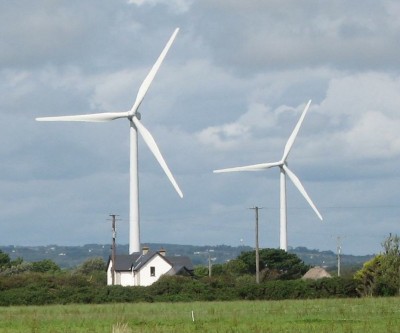
****
Health problems in Finland caused by infrasound from wind turbine
Windwatch.org
4 December 2015
Source: National Wind Watch
Author: Tuulivoima-kansalaisyhdistys ry
From the English press release:
Tuulivoima-kansalaisyhdistys (TV-KY) ry – the National Association of Citizens Against Giant Windmills – has recently released an extensive report on the infrasound emissions from wind turbines and their impact on people’s health.
The wind turbines being built in close proximity to residential areas in Finland are the biggest in Europe. Their rotating blades generate low frequency noise and infrasound, i.e. frequent and continuous air pressure pulses that can travel for very long distances.
Low frequency noise refers to frequencies between 20-200 Hz that are audible to the human ear, and infrasound refers to frequencies between 0.1-20 Hz that can’t be picked up by the human ear.
Wind power companies, as well as some researchers, have claimed that “infrasound can’t cause adverse health effects as it is inaudible”. Similarly, we could maintain that radiation isn’t harmful as it is beyond sensory perception.
However, in the summer of 2015 the German Max Planck Institute released a study conducted using a new kind of measurement technology.
Contrary to the well-established view, the study showed that the alarm mechanisms of the human brain are sensitive to very low infrasound that is below the hearing threshold.
The need for a survey conducted by the TV-KY Association arose when a growing number of residents in areas located near wind farms started to report health problems, some of which were serious. The measurements showed that the rapidly changing low frequency noise and infrasound caused by wind turbines can indeed be measured inside Finnish homes.
Low frequencies permeate the structures of buildings and they can be disturbingly distinguishable from background noise, particularly indoors.
Infrasound, on the other hand, can’t be picked up by the human ear, but the residents complain over a great number of symptoms, some of which are serious. The emergence and degree of problems depend on the strength and length of exposure.
In Finland, large scale wind farms have only been constructed for a few years. We don’t yet have any records of the number of people who have had health problems caused by the infrasound emissions of wind turbines.
For this report, we interviewed 12 Finnish families who live in close proximity to giant wind turbines in Finland, and we collected the experiences of 55 people concerning the health impacts of industrial wind power production. Out of these 55 people, 33 suffer from sleep disturbances, 26 from ear problems, 23 from headache, 17 from nausea, 11 from heart problems and 11 from inertia.
In addition to infrasound emissions, the audible low frequency noise of the up to 230 m tall wind turbines is directed with force horizontally away from the rotating blades, both downwind and against the wind.
The massive air pressure pulse, generated by the blades, that varies with 1-2 seconds intervals, produces low frequency noise that isn’t actually directed at the foot of the wind turbine or on the side.
This partly explains why the interviewed residents in areas that are close to wind farms don’t react identically to wind turbine noise, which is at its worst during night time.
In our measurements, we used a microbarometer, an exceedingly accurate instrument for measuring atmospheric pressure. The measurements were carried out in homes that had reported adverse health effects caused by wind turbines. The report presents the noise measurements carried out inside the homes of some families interviewed in the survey. The infrasound emissions from wind turbines were clearly perceivable.
The report describes what types of well-known health problems are caused by infrasound and what kind of mechanisms are involved. In addition to this, the report contains basic information on the infrasound emissions of wind turbines and on how those emissions can be measured.
Windwatch.org


Reblogged this on Patti Kellar and commented:
Very informative, especially for those who don’t understand just how far infrasound can travel. So many people not connecting the dots as to why they are waking up in the middle of the night for no apparent reason.
Just like in Waterloo South Australia, and in any country around the world where you find wind turbines, the shit is hitting the fans.
Keith,
Have sent this one to the Commissioner.
Annie
We are truly grateful to all those who are doing the investigations that are required to be commissioned by the regulatory authorities and then made available to those who are affected.
The inappropriate conduct by those in the planning department and the local council have failed in their duty of care by NOT ensuring that noise compliance and complaint procedures are independent of the operator or the proponent.
After ACCIONA reneged on their commitment to us to supply the Marshall Day report done in June 2009, I undertook my own investigations, using a sound pressure meter and an air pressure meter. These instruments, the information obtained identified to me that there is air/sound pressure pulsing which was consistent with verbal advice from Marshall Day in mid June 2009 of air pressure pulsations being a serious issue.
We then commissioned the ‘Dean Report’, made public in July 2010 and then 2 follow-up supplementary reports, provided to the planning minister and the Planning Department of Victoria.
In June 2012 and June/July 2014, these reports identified sound and air pressure pulsing and their potential to cause harm. The report was sent to the Developer, Planning Department and the local Council to demonstrate the possible causes for our complaints in relation to noise and vibration; where noise generated did not comply with the limits set under the NZ standard; and we demanded that these breaches be properly investigated.
The Planning Department commissioned a peer review of evidence in the Dean Report and the Marshall Day report. Its report supported the non-compliance findings made in the Dean Report and identified the numerous faults and failings of the MDA report.
As a Complainant, I am only required by law to make a complaint to the Developer; and to register an act of nuisance with the Council.
It is the responsibility of the developer, the Planning Department and the Council to investigate (ie to verify the substance of the complaint) and then present the results of that investigation to me in order to discharge their legal obligations to me and my family. This has never occurred, and as such they have breached their duty of care.
This investigation in Finland appears to consider the noise effects generated inside of homes, using instruments that are in a fixed position.
I believe the main effects that we suffer occur when we are traveling on roads and around our property from the pulsing effect experienced to the greatest degree when situated in line with several turbines in a row, like where our house is. I once stopped on the side of the road, in line with about 5 turbines, and became very ill; and have not fully recovered since that.
I believe the sounds being measured inside houses in the Windtest reports are coming from turbines; and appear to be resonating at the rate of air pressure fluctuations caused by turbine operation. In other words, sound is traveling at the speed of sound and resonating at the speed of change in air pressure, at about 1 to 2 second intervals.
We were still dreadfully effected after we abandoned our when working elsewhere on our property. For that reason, I consider it very important that the sound air pressure be measured when moving. That way, air pressure changes being experienced when moving – walking or driving could be detected. It was in those circumstances that I first identified and measured those changes.
I feel it is very important the testing be done while in motion to pick up the full extent of trough to peak in real time. That way, the constructive interference from turbines placed too close to each other – and the sound that resonates from walls and hard surfaces inside homes – can be compared to those outside of homes, so as to identify the pulsing sound/air pressure changes when going indoors to outdoors or visa-versa. This is the only way that harm can be properly mitigated by the responsible authorities and done so ASAP.
Noel Dean
…and Canada, the US, Mexico, Africa, and EVERYWHERE THAT INDUSTRIAL WIND TURBINES APPEAR!
Add Canada as well.
Reblogged this on Climatism and commented:
The crazed rush to “save the planet” from a non-problem, with unreliable and ungreen energy, administered by sanctimonious politicians and green carpet naggers out to boast who’s ‘greener’ than who, now causing untold damage to people’s lives, destroying pristine environments and decimating avian life and their habitats.
Ahhh the sickening irony.
And to think for every industrial wind turbine that is erected, a (predominantly) fossil fuel powered backup station needs to be built in support to provide reliable 24/7 baseload power when the wind don’t blow!
What an insane and devastating joke the entire ‘green’ energy revolution has become.
We will look back at this time of collective eco-insanity and wonder what on earth were we (they) thinking.
Yep, the same in everyone’s language: from Finland to Japan to Iran… Who said there were no problems in non-English speaking countries, huh?
And you can add Germany, France, Turkey and Greece to the list too.